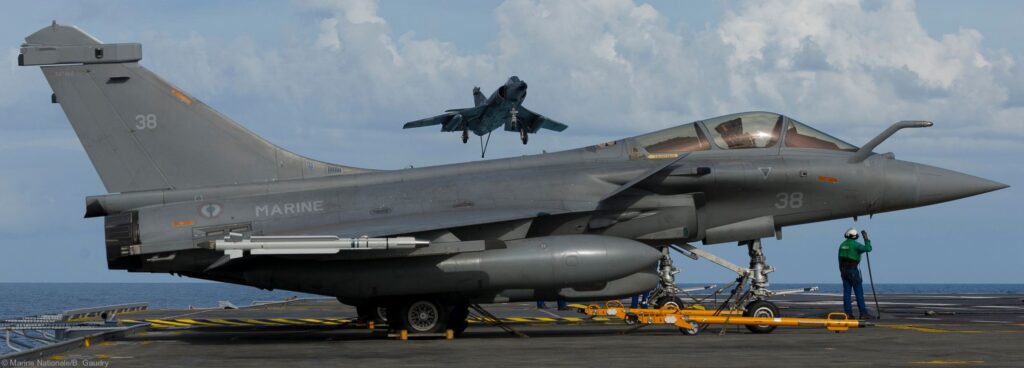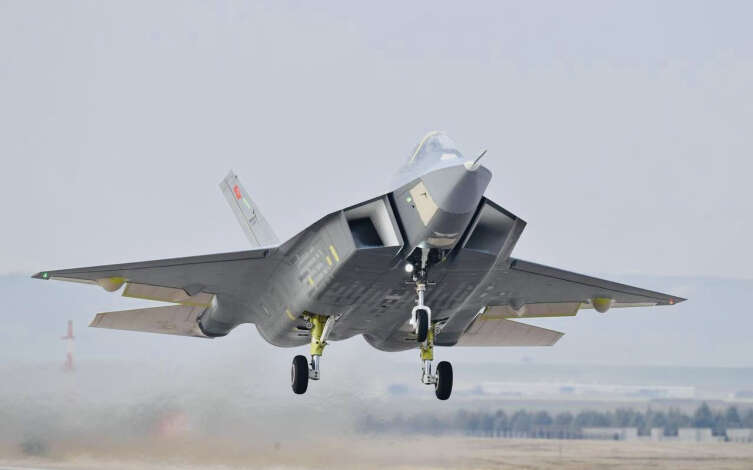India and France are currently engaged in critical negotiations for the procurement of 26 Rafale Marine fighter jets for the Indian Navy. These talks, initially scheduled for May 30 but postponed to June due to the Lok Sabha election process, are focusing on pricing and other key aspects of the deal.
The French delegation, including officials from their Directorate General of Armament, is in New Delhi to discuss the sale of these advanced aircraft to India.
Also read this :- “With 1000 J-20s by 2035, Can India’s 5th-Gen AMCA Counter China’s PLAAF?”
The proposed deal, estimated to be worth over Rs 50,000 crore (approximately $6 billion), would significantly boost India’s naval air capabilities. If finalized, this acquisition would increase India’s total Rafale fleet to 62 aircraft, complementing the 36 Rafale jets already in service with the Indian Air Force.
The Rafale Marine fighters are intended for deployment on India’s aircraft carriers, INS Vikramatritya and INS Vikrant, enhancing the country’s maritime defense capabilities.
France submitted its response to India’s tender for the 26 Rafale Marine jets in December of the previous year, responding to India’s Letter of Acceptance.
The current negotiations are being conducted on a government-to-government basis, with India’s Directorate General of Acquisition under the Ministry of Defence leading the talks alongside military officers representing the end-users. The Indian side is working to secure the most favorable terms possible in this strategic acquisition.
The Indian Navy plans to base these aircraft at INS Degha in Visakhapatnam, Andhra Pradesh, as their home station. This deployment will significantly enhance India’s naval air power projection capabilities in the Indian Ocean region.
The acquisition of these advanced fighter jets aligns with India’s broader strategy to modernize its armed forces and strengthen its maritime defense posture, particularly in light of evolving geopolitical dynamics in the Indo-Pacific region.
Rafale M Fighter Jet Aircraft
The Dassault Rafale (literally meaning “gust of wind”, and “burst of fire” in a more military sense) is a French twin-engine, canard delta wing, multirole fighter aircraft designed and built by Dassault Aviation. Equipped with a wide range of weapons, the Rafale is intended to perform air supremacy, interdiction, aerial reconnaissance, ground support, in-depth strike, anti-ship strike and nuclear deterrence missions. The Rafale is referred to as an “omnirole” aircraft by Dassault.

In the late 1970s, the French Air Force and Navy were seeking to replace and consolidate their current fleets of aircraft. In order to reduce development costs and boost prospective sales, France entered into an arrangement with UK, Germany, Italy and Spain to produce an agile multi-purpose fighter, the Eurofighter Typhoon. Subsequent disagreements over workshare and differing requirements led to France’s pursuit of its own development program.
Dassault built a technology demonstrator which first flew in July 1986 as part of an eight-year flight-test programme, paving the way for the go-ahead of the project. The Rafale is distinct from other European fighters of its era in that it is almost entirely built by one country, involving most of France’s major defence contractors, such as Dassault, Thales and Safran.

Many of the aircraft’s avionics and features, such as direct voice input, the RBE2 AA active electronically scanned array (AESA) radar and the optronique secteur frontal infra-red search and track (IRST) sensor, were domestically developed and produced for the Rafale programme. Originally scheduled to enter service in 1996, the Rafale suffered significant delays due to post-Cold War budget cuts and changes in priorities. The aircraft is available in three main variants: Rafale C single-seat land-based version, Rafale B twin-seat land-based version, and Rafale M single-seat carrier-based version.
Introduced in 2001, the Rafale is being produced for both the French Air Force and for carrier-based operations in the French Navy. The Rafale has been used in combat over Afghanistan, Libya, Mali, Iraq and Syria. Several upgrades to the weapons and avionics of the Rafale are planned to be introduced by 2018.
In December 2000, the French Naval Aviation (Aéronavale), the air arm of the French Navy, received its first two Rafale M fighters. On 18 May the following year, the squadron Flottille 12F, which had previously operated the F-8 Crusader, became the first squadron to operate the Rafale after it was officially re-activated prior to the delivery of the sixth Rafale. Flottille 12F immediately participated in Trident d’Or aboard the aircraft carrier Charles de Gaulle with warships from ten other nations.
During the maritime exercise, the Navy tested the Rafale’s avionics during simulated interceptions with various foreign aircraft, in addition to carrier take-offs and landings. After almost four years of training, the Rafale M was declared operational with the French Navy in June 2004.
42 aircraft were delivered to the Marine Nationale.

The Rafale M is fully compatible with US Navy aircraft carriers and some French Navy pilots have qualified to fly the aircraft from US Navy flight decks. On 4 June 2010, during an exercise on USS Harry S. Truman, a French Rafale became the first jet fighter of a foreign navy to have its engine replaced on board an American aircraft carrier.
In 2002, the Rafales were first deployed to a combat zone; seven Rafale Ms embarked aboard Charles de Gaulle of the French Navy during “Mission Héraclès”, the French participation in “Operation Enduring Freedom”. They flew from the aircraft carrier over Afghanistan, but the F1 standard precluded air-to-ground missions and the Rafale did not see any action. In June 2002, while Charles de Gaulle was in the Arabian Sea, Rafales conducted several patrols near the India-Pakistan border.
In 2016, Rafales operating from Charles de Gaulle struck targets associated with the Islamic State of Iraq and the Levant.
In December 2015, American and French military officials reportedly discussed the possibility of French naval Rafale Ms flying combat missions from a US Navy Nimitz-class aircraft carrier as soon as January 2017. This would enable continued French Navy operations against ISIL while Charles de Gaulle undergoes its year and a half-long major refit, scheduled to begin in early 2017. Although Rafales have launched and landed on U.S. carriers to demonstrate interoperability, it would be the first time they would fly combat missions from one.
As many as 18 Rafale Ms could be deployed on a carrier, although some room would have to be made for French Navy support crews familiar with maintaining the Rafale, as well as for spare parts and munitions. Operation Chesapeake, a test of this interoperability, was conducted in May 2018, when 12 Rafales of Flottilles 11F, 12F, and 17F, along with nearly 350 support personnel embarked aboard USS George H.W. Bush for two weeks of carrier qualifications and exercises after conducting a month of shore based training at Naval Air Station Oceana.
Technical data:
Length: 15.27 m (50.1 ft)
Wingspan: 10.80 m (35.4 ft)
Height: 5.34 m (17.5 ft)
Wing area: 45.7 m2 (492 ft2)
Empty weight: 10300 kilograms (22700 lb) (B) / 9850 kilograms (21720 lb) (C) / 10600 kilograms (23400 lb) (M)
Loaded weight: 15000 kilograms (33000 lb)
Max. takeoff weight: 24500 kilograms (54000 lb) (B/C/D)
Fuel capacity: 4700 kg (10400 lb) internal for single-seater (C); 4400 kg (9700 lb) for two-seater (B)
Powerplant: 2 x Snecma M88-2 turbofans
Dry thrust: 50.04 kN (11250 lbf) each
Thrust with afterburner: 75 kN (16860 lbf) each
Maximum speed: High altitude: Mach 1.8 (1912 km/h; 1032 knots) / Low altitude: Mach 1.1 (1390 km/h; 750 knots)
Range: >3700 km (>2000 nmi) with 3 drop tanks
Combat radius: >1852 km (>1000 nmi) on penetration mission with two CFTs (2300 L), three tanks (5700 L), two SCALP-EG and two MICA AAMs.
Service ceiling: 15235 m (50000 ft)
Rate of climb: >304.8 m/s (>60000 ft/min)
Wing loading: 328 kg/m2 (67.1 lb/ft2)
Thrust/weight: 0.988 (100% fuel, 2 EM A2A missile, 2 IR A2A missile) version B
Maximum g-load: +9/−3.6g (+11g in emergencies)
Armament:
Gun: 1 x 30 mm (1.2 in) GIAT 30/M791 autocannon with 125 rounds
Hardpoints:
14 for Air Force versions (Rafale B/C), 13 for Navy version (Rafale M) with a capacity of 9,500 kg (20,900 lb) external fuel and ordnance and provisions to carry combinations of:
Weapons:
Air-to-air:
Magic II
MBDA MICA IR or EM
MBDA Meteor (planned)
Air-to-ground:
MBDA Apache
MBDA Storm Shadow/SCALP-EG
AASM-Hammer (SBU-38/54/64)
GBU-12 Paveway II, GBU-22 Paveway III, GBU-24 Paveway III, GBU-49 Enhanced Paveway II
AS-30L AGM
Mark 82 bomb
Air-to-surface:
MBDA AM 39-Exocet anti-ship missile
Nuclear Deterrence:
ASMP-A nuclear missile
Other:
Thales Damocles targeting pod
Thales AREOS (Airborne Recce Observation System) reconnaissance pod
Thales TALIOS multi-function targeting pod in the future (F3R Standard)
Up to 5 drop tanks
Buddy-buddy refuelling pod
Avionics:
Thales RBE2-AA AESA radar
Thales SPECTRA Electronic Warfare system.
Thales/SAGEM-OSF Optronique Secteur Frontal infra-red search and track (IRST) system


Pingback: IAF To Get More Power With Gen-5 Fighter - DEFENCE AFGHANISTAN